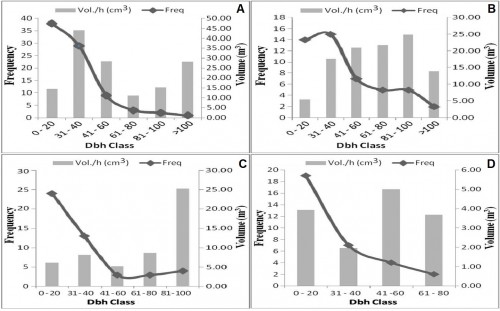Tropical Plant Research
An International Journal by Society for Tropical Plant Research
2017, VOLUME 4 ISSUE 3Pages: 496-513
Phytoecological studies of some protected and degraded forest areas of Lowland Humid forest, Ondo state Nigeria: a Comparative approach
Iyagin F. O. * and Adekunle V. A. J.
*Department of Forestry and Wood Technology, Federal University of Technology Akure, P.M.B 704, Ondo State, Akure, Nigeria
Abstract:
This study compared the phytoecological characteristics of some protected areas [Strict nature reserve (SNR), Oluwa natural forest (ONF) and permanent sample plot 29 aimed at biodiversity conservation and a degraded forest not under reservation] in the lowland humid forest, Ondo state, Nigeria. Data were collected using Systematic Line Transect method with two parallel transects of 200 m apart for plot location. Four sample plots (25 m × 25 m) were laid alternately on each transect in each of the forests. In each plot, trees with DBH ≥ 10 cm were measured (diameters at the base, middle, top and total height), identified and classified into families and frequency of occurrence to ascertain the present status of the protected areas in term of tree diversity, abundance and yield. A total of 411 stems.ha-1 from 78 species and 30 families was recorded in the study sites. Celtis zenkeri, Cola gigantea and Funtumia elastica were common to all the forests. The DBH distribution curve of the species followed inverse J-shaped pattern with 49.4% of trees falling within the lowest diameter class (10–20 cm) while only 7.14% falls in the highest diameter class (>80 cm). SNR and ONF have emergent trees whose heights were above 30 m (18.7% and 7.02% of the total number of trees in the Sterculaceae and Meliaceae families, respectively) whereas 14.90 m was the highest height recorded in the free forest. On biovolume yield, ONF has the highest volume per hectare (141.06 m3) while the least (14.56 m3) was from the forest not under reservation. The Shannon-Weiner index, Pielou’s Evenness index and Margalef's index for all the forest reserves are 5.11, 0.69 and 12.79 respectively with the highest for ONF. These indices indicated that the protected areas are mature and foster in-situ conservation of tree species especially the keystone species.
This study compared the phytoecological characteristics of some protected areas [Strict nature reserve (SNR), Oluwa natural forest (ONF) and permanent sample plot 29 aimed at biodiversity conservation and a degraded forest not under reservation] in the lowland humid forest, Ondo state, Nigeria. Data were collected using Systematic Line Transect method with two parallel transects of 200 m apart for plot location. Four sample plots (25 m × 25 m) were laid alternately on each transect in each of the forests. In each plot, trees with DBH ≥ 10 cm were measured (diameters at the base, middle, top and total height), identified and classified into families and frequency of occurrence to ascertain the present status of the protected areas in term of tree diversity, abundance and yield. A total of 411 stems.ha-1 from 78 species and 30 families was recorded in the study sites. Celtis zenkeri, Cola gigantea and Funtumia elastica were common to all the forests. The DBH distribution curve of the species followed inverse J-shaped pattern with 49.4% of trees falling within the lowest diameter class (10–20 cm) while only 7.14% falls in the highest diameter class (>80 cm). SNR and ONF have emergent trees whose heights were above 30 m (18.7% and 7.02% of the total number of trees in the Sterculaceae and Meliaceae families, respectively) whereas 14.90 m was the highest height recorded in the free forest. On biovolume yield, ONF has the highest volume per hectare (141.06 m3) while the least (14.56 m3) was from the forest not under reservation. The Shannon-Weiner index, Pielou’s Evenness index and Margalef's index for all the forest reserves are 5.11, 0.69 and 12.79 respectively with the highest for ONF. These indices indicated that the protected areas are mature and foster in-situ conservation of tree species especially the keystone species.

Fig.: Tree species population structure of the study areas based on DBH (cm) classes with frequency and volume (m3) (A, Oluwa Forest Reserve; B, SNR Aponmu; C, PSP 29; D, Free Forest).
| 0 | 1 | 2 | 5 | 5 | 3 | 5 | 9 |


